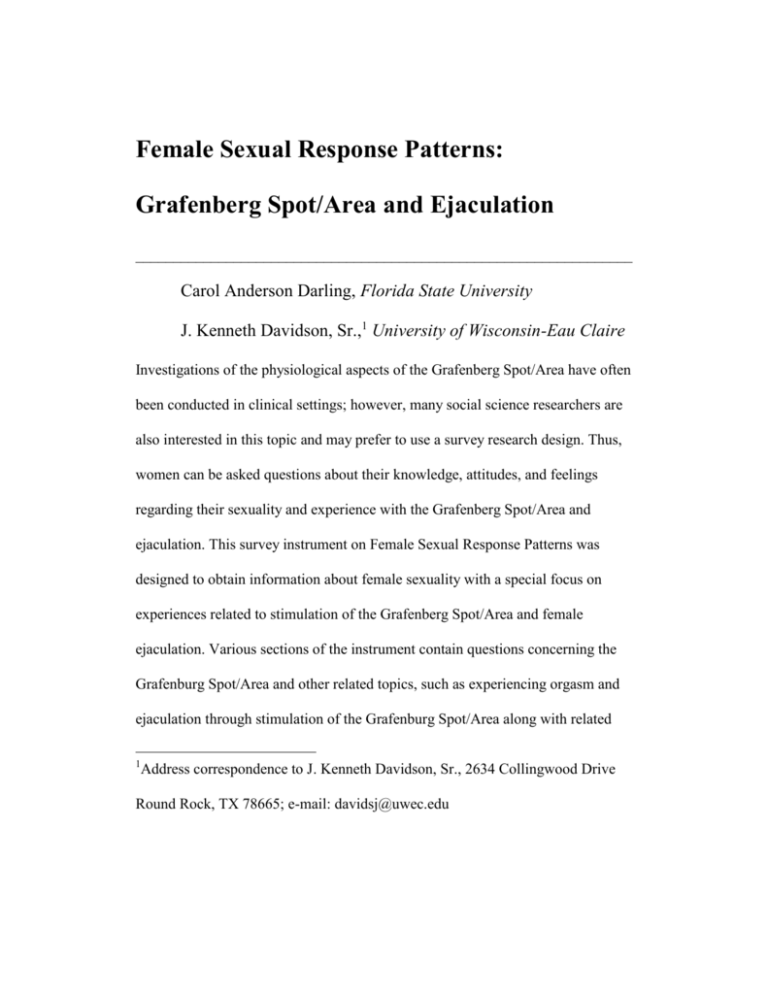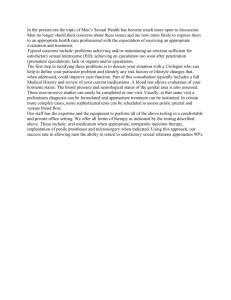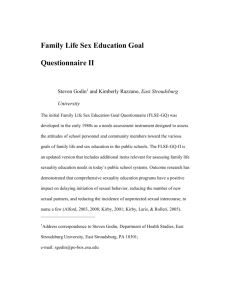
Female Sexual Response Patterns:
Grafenberg Spot/Area and Ejaculation
__________________________________________________________________
Carol Anderson Darling, Florida State University
J. Kenneth Davidson, Sr.,1 University of Wisconsin-Eau Claire
Investigations of the physiological aspects of the Grafenberg Spot/Area have often
been conducted in clinical settings; however, many social science researchers are
also interested in this topic and may prefer to use a survey research design. Thus,
women can be asked questions about their knowledge, attitudes, and feelings
regarding their sexuality and experience with the Grafenberg Spot/Area and
ejaculation. This survey instrument on Female Sexual Response Patterns was
designed to obtain information about female sexuality with a special focus on
experiences related to stimulation of the Grafenberg Spot/Area and female
ejaculation. Various sections of the instrument contain questions concerning the
Grafenburg Spot/Area and other related topics, such as experiencing orgasm and
ejaculation through stimulation of the Grafenburg Spot/Area along with related
1
Address correspondence to J. Kenneth Davidson, Sr., 2634 Collingwood Drive
Round Rock, TX 78665; e-mail: davidsj@uwec.edu
urinary and bladder conditions.
Description
The entire instrument consists of 192 open-ended and closed-form items. Several
variables were included concerning demographics, parent-child attachment,
childhood/adolescence, socialization, partner relationships, sexual attitudes,
sexual behaviors, and knowledge and/or experience with the Grafenberg
Spot/Area and female ejaculation. It was important to us to obtain accurate
descriptions of the location of the Grafenburg Spot/Area and source of
ejaculation. Thus, these questions were open-ended and contained labeled
diagrams of the female anatomy. Although these diagrams were used each time a
question related to "location" was asked, the diagrams are included only once in
this description.
We chose not to use the name "Grafenberg Spot,” which had been
familiarized in the popular press, because its use could possibly result in
preformed notions, bias, or confusion for the respondents. Thus, the terminology
used throughout the questionnaire refers to an "especially sensitive area in your
vagina." There were four sections of questions pertinent to the "sensitive area,"
including sensitive area, sensitive area orgasm, sensitive area ejaculation, and
sensitive area urination/pubococcygeus musculature. These sections are not
identified in the actual questionnaire, although subtitles have been included to
provide clarity in this condensed version of the instrument. Because the questions
pertaining to the sensitive area were distributed throughout the instrument, they
are not numbered within this description. Furthermore, if the question did not
apply, the respondent was directed to another question by "if and go" statements.
The instrument was first pretested with female students enrolled in an upperdivision human sexuality course. A revised questionnaire was pretested utilizing
acquaintances of professional colleagues in various academic settings. Finally the
questionnaire was reviewed by six female professionals involved in either
teaching and/or research about human sexuality and/or sex education as part of the
process of developing the final draft of the questionnaire. The actual investigation
involved an anonymous survey of 2,350 professional women in health-related
fields in the U.S. that yielded 1,289 completed questionnaires. A purposeful
sample of women employed in the fields of nursing, sex education, sex therapy,
and counseling was used. Given the nature of their academic training, it was
assumed that these individuals would have a degree of familiarity with the
anatomical structures and physiological processes associated with sexual
responsiveness. Although the respondents were well-educated, their expertise was
deemed important in order to reply in more precise language to a number of openform items contained in the survey instrument.
This survey instrument is best suited for utilization with populations that
contain women with 2 or more years of college education and who are at least 25
years of age. The level of language sophistication found in the instrument would
appear to preclude its application to populations that have no college education.
Furthermore, given the nature of the instrument, a woman would need to be
sexually experienced in order to be able to respond in a meaningful way to a
substantial number of the items. It is assumed that a greater opportunity for having
considerable sexual experience will exist for women ages 25 years or older.
Additional material pertaining to this scale, including information about
format, scoring, reliability, and validity is available in Fisher, Davis, Yarber, and
Davis (2010).
Fisher, T. D., Davis, C. M., Yarber, W. L., & Davis, S. L. (2010). Handbook of
Sexuality-Related Measures. New York: Routledge.









